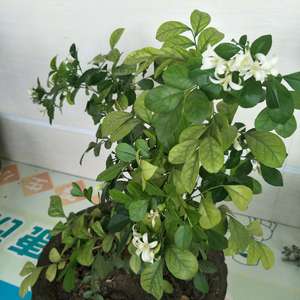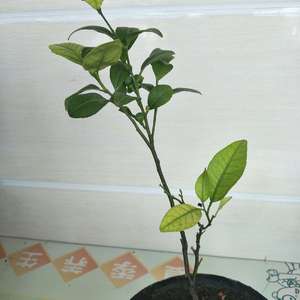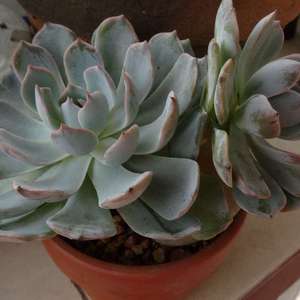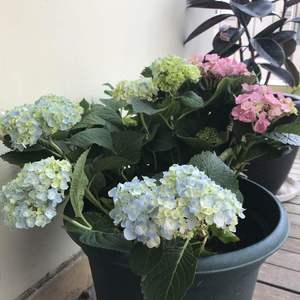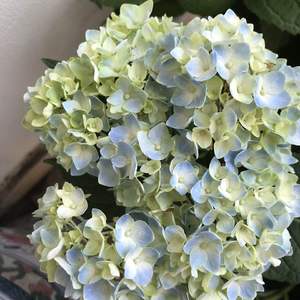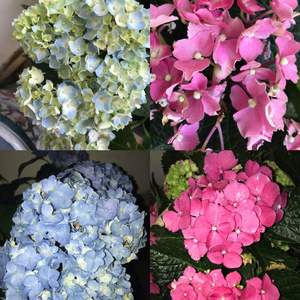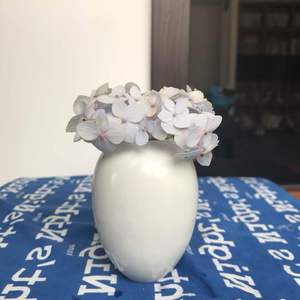文章
Miss Chen
2018年06月26日

Description: This annual plant is about 3-10" tall and more or less erect. It form short side branches along the upper half of the central stem, and sometimes branches along its lower half as well. The stems are light green and pubescent. The middle to upper opposite leaves are lanceolate, oblanceolate, or ovate; they are up to 1¾" long and ½" across. In contrast, the lowermost opposite leaves are linear-oblong; they are about the same length as the other leaves, but more narrow. Both kinds of leaves are light to medium green, hairless, sessile, and dentate or smooth along the margins.
Individual flowers develop from the axils of the upper leaves on pedicels up to 1" long. Each flower has a tubular corolla about 1/3" long and a short tubular calyx with 5 teeth. The front of the corolla is mostly white, while its lower exterior is pale yellow or green with fine veins. The outer rim of the corolla has several spreading lobes that are short and rounded. Inside the corolla, there are 2 fertile stamens, 2 abortive stamens, and a slender style. The exterior of the calyx is green and pubescent; its teeth are slender and often recurved. At the base of each flower, there are a pair of small leafy bracts that are lanceolate or lanceolate-linear in shape. The blooming period can occur from late spring into the fall. While this is a long time period, individual plants usually bloom for only 1-2 months before they die down. Each flower is replaced by a small seed capsule that is ovoid and pointed at its apex; it contains many small seeds. The root system consists of a slender branching taproot. This plant spreads by reseeding itself, and it readily forms colonies at favorable sites.
Cultivation: The preference is full sun to light shade, wet conditions, and exposed muddy soil. Shallow water is tolerated if it is temporary. This opportunistic plant develops very quickly from seed when the ground is wet. It also dies down quickly after its seeds become mature.
Range & Habitat: Clammy Hedge Hyssop is occasional to locally common throughout Illinois, where it is native. Habitats include floodplain forests, muddy depressions in upland woodlands, gravelly seeps, degraded soggy meadows, mud puddles along woodland paths, and poorly drained fields. This little plant likes to colonize disturbed areas.
Faunal Associations: The nectar and pollen of the flowers attract Halictid bees and other small bees. The tiny seeds probably cling to the feet of animals and the shoes of humans as they pass through the muddy areas where this plant grows. Later, these seeds are released into new areas where they may germinate.
Photographic Location: A muddy depression in Busey Woods, Urbana, Illinois.
Comments: This is another small annual in the Figwort family. Unless a large colony happens to be in bloom, it is easy to overlook. Clammy Hedge Hyssop can be distinguished from a similar species, Gratiola virginiana (Round-Fruited Hedge Hyssop), by its pubescent stems and ovoid seed capsules. In contrast, the latter species has succulent glabrous stems and globoid seed capsules. Another small annual in the Figwort family that likes wetland areas, Lindernia dubia (False Pimpernel), lacks pairs of leafy bracts underneath its flowers. Its leaves are usually wider in shape and more shiny than those of Clammy Hedge Hyssop. In spite of the common name, Clammy Hedge Hyssop is not normally found around hedges. This probably refers to the habitat preferences of a European species in this genus.
Individual flowers develop from the axils of the upper leaves on pedicels up to 1" long. Each flower has a tubular corolla about 1/3" long and a short tubular calyx with 5 teeth. The front of the corolla is mostly white, while its lower exterior is pale yellow or green with fine veins. The outer rim of the corolla has several spreading lobes that are short and rounded. Inside the corolla, there are 2 fertile stamens, 2 abortive stamens, and a slender style. The exterior of the calyx is green and pubescent; its teeth are slender and often recurved. At the base of each flower, there are a pair of small leafy bracts that are lanceolate or lanceolate-linear in shape. The blooming period can occur from late spring into the fall. While this is a long time period, individual plants usually bloom for only 1-2 months before they die down. Each flower is replaced by a small seed capsule that is ovoid and pointed at its apex; it contains many small seeds. The root system consists of a slender branching taproot. This plant spreads by reseeding itself, and it readily forms colonies at favorable sites.
Cultivation: The preference is full sun to light shade, wet conditions, and exposed muddy soil. Shallow water is tolerated if it is temporary. This opportunistic plant develops very quickly from seed when the ground is wet. It also dies down quickly after its seeds become mature.
Range & Habitat: Clammy Hedge Hyssop is occasional to locally common throughout Illinois, where it is native. Habitats include floodplain forests, muddy depressions in upland woodlands, gravelly seeps, degraded soggy meadows, mud puddles along woodland paths, and poorly drained fields. This little plant likes to colonize disturbed areas.
Faunal Associations: The nectar and pollen of the flowers attract Halictid bees and other small bees. The tiny seeds probably cling to the feet of animals and the shoes of humans as they pass through the muddy areas where this plant grows. Later, these seeds are released into new areas where they may germinate.
Photographic Location: A muddy depression in Busey Woods, Urbana, Illinois.
Comments: This is another small annual in the Figwort family. Unless a large colony happens to be in bloom, it is easy to overlook. Clammy Hedge Hyssop can be distinguished from a similar species, Gratiola virginiana (Round-Fruited Hedge Hyssop), by its pubescent stems and ovoid seed capsules. In contrast, the latter species has succulent glabrous stems and globoid seed capsules. Another small annual in the Figwort family that likes wetland areas, Lindernia dubia (False Pimpernel), lacks pairs of leafy bracts underneath its flowers. Its leaves are usually wider in shape and more shiny than those of Clammy Hedge Hyssop. In spite of the common name, Clammy Hedge Hyssop is not normally found around hedges. This probably refers to the habitat preferences of a European species in this genus.
0
0
文章
Miss Chen
2018年06月26日

Description: This shrub is 1-3' tall, branching occasionally. The woody branches near the base of this shrub have yellowish brown to reddish brown bark that often becomes shredded into white strips or narrow sheets. Young stems are light green, glabrous, and 4-angled. Pairs of opposite primary leaves occur along the young stems. In addition, there are often clusters of smaller secondary leaves near the axils of the opposite primary leaves. These leaves are up to 2" long and 8 mm. (1/3") across; they are linear-oblong to oblanceolate in shape and their margins are entire (toothless) and revolute (rolled downward). The upper leaf surface is bluish green to medium green, glabrous, and sometimes glaucous, while the lower leaf surface is light green, glabrous, and sometimes glaucous. All leaves are sessile or nearly so. The upper stems terminate in corymbs or compound corymbs of 3-7 flowers.
Each flower is about 1–1¼" across, consisting of 5 spreading yellow petals, 5 light green or light yellow sepals, a light yellow pistil with 5 styles (the latter are often united), and numerous conspicuous stamens. The petals are broadly oblong or obovate in shape, while the sepals are lanceolate; the petals are about twice the length of the sepals. The filaments of the stamens are light yellow, while the anthers are medium yellow or golden yellow. The pedicels of the flowers are up to ¾" long, light green, and glabrous. The blooming period occurs from mid-summer to late summer, lasting about 1 month. Afterwards, the flowers are replaced by seed capsules about 8 mm. (1/3") long that are lanceoloid in shape and 5-lobed. The interior of each seed capsule has 5 completely separated cells; there are numerous seeds in each cell. These seeds are dark-colored, narrowly oblongoid, and somewhat flattened. The woody root system is shallow and spreading.

Cultivation: The preference is full sun, wet to moist conditions, and soil containing calcareous sand or limestone. Shallow water is tolerated if it is temporary. This shrub is winter-hardy to Zone 4.
Range & Habitat: Kalm's St. John's Wort occurs in NE Illinois along Lake Michigan, where it is native (see Distribution Map). In Illinois, this shrub is rare and state-listed as 'endangered.' It is endemic to the Great Lakes Region. Habitats include interdunal swales, borders of small sandy ponds, moist to wet sandy meadows, and moist sand flats (pannes). Outside of Illinois, Kalm's St. John's Wort occurs on limestone flats (alvars). This shrub is found in high quality natural areas. It is also cultivated occasionally in gardens because of its showy flowers.

Faunal Associations: Mostly various bees visit the flowers, where they collect pollen. Nectar is not available as a floral reward. Grundel et al. (2011) observed a leaf-cutting bee (Megachile montivaga) and Halictid bees (Augochlorella aurata, Lasioglossum pectorale) visiting the flowers of Kalm's St. John's Wort. Two oligophagous aphids suck the sap of this shrub: Aphis mizzou and Aphis hyperici. The caterpillars of an oligophagous moth, Nedra ramosula (Gray Half-spot), feeds on St. John's Wort species (Hypericum spp.), while the caterpillars of two polyphagous moths, Eupithecia miserulata (Common Pug) and Synchlora aerata (Wavy-lined Emerald), sometimes feed on the flowers (Lagos et al., 2012; Covell, 1984/2005; Wagner, 2005).

Kalm's St. John's Wort is rarely browsed by White-tail Deer. In places where this animal is abundant, this shrub has a tendency to increase because of selective browsing (Bradstreet & Bowles, 2002). The leaves of St. John's Wort species are somewhat toxic to domesticated farm animals, particularly those with white or thin fur. These plants contain a toxin that increases sensitivity to the ultraviolet radiation of sunlight, causing irritation of the skin. Consumption of these plant species can also irritate the gastrointestinal tract of these animals.
Photographic Location: Border of a small sandy pond and a moist sandy meadow near Lake Michigan in NE Illinois.

Comments: Populations of this small showy shrub appear to be increasing in some protected areas of Illinois. Kalm's St. John's Wort can be distinguished from most species of St. John's Wort (Hypericum spp.) by its woody lower branches; most species of St. John's Wort in Illinois are entirely herbaceous. Compared to another shrubby species, Shrubby St. John's Wort (Hypericum prolificum), Kalm's St. John's Wort has more narrow leaves (never exceeding 8 mm. across) and it has 5-celled seed capsules, rather than 3-celled seed capsules. It is similar to another shrubby species that is found in southern Illinois, Five-lobed St. John's Wort (Hypericum lobocarpum). This latter species has cymes with a greater number of flowers (usually exceeding 7 flowers each) and its flowers are smaller in size (about ¾" across).
Each flower is about 1–1¼" across, consisting of 5 spreading yellow petals, 5 light green or light yellow sepals, a light yellow pistil with 5 styles (the latter are often united), and numerous conspicuous stamens. The petals are broadly oblong or obovate in shape, while the sepals are lanceolate; the petals are about twice the length of the sepals. The filaments of the stamens are light yellow, while the anthers are medium yellow or golden yellow. The pedicels of the flowers are up to ¾" long, light green, and glabrous. The blooming period occurs from mid-summer to late summer, lasting about 1 month. Afterwards, the flowers are replaced by seed capsules about 8 mm. (1/3") long that are lanceoloid in shape and 5-lobed. The interior of each seed capsule has 5 completely separated cells; there are numerous seeds in each cell. These seeds are dark-colored, narrowly oblongoid, and somewhat flattened. The woody root system is shallow and spreading.

Cultivation: The preference is full sun, wet to moist conditions, and soil containing calcareous sand or limestone. Shallow water is tolerated if it is temporary. This shrub is winter-hardy to Zone 4.
Range & Habitat: Kalm's St. John's Wort occurs in NE Illinois along Lake Michigan, where it is native (see Distribution Map). In Illinois, this shrub is rare and state-listed as 'endangered.' It is endemic to the Great Lakes Region. Habitats include interdunal swales, borders of small sandy ponds, moist to wet sandy meadows, and moist sand flats (pannes). Outside of Illinois, Kalm's St. John's Wort occurs on limestone flats (alvars). This shrub is found in high quality natural areas. It is also cultivated occasionally in gardens because of its showy flowers.

Faunal Associations: Mostly various bees visit the flowers, where they collect pollen. Nectar is not available as a floral reward. Grundel et al. (2011) observed a leaf-cutting bee (Megachile montivaga) and Halictid bees (Augochlorella aurata, Lasioglossum pectorale) visiting the flowers of Kalm's St. John's Wort. Two oligophagous aphids suck the sap of this shrub: Aphis mizzou and Aphis hyperici. The caterpillars of an oligophagous moth, Nedra ramosula (Gray Half-spot), feeds on St. John's Wort species (Hypericum spp.), while the caterpillars of two polyphagous moths, Eupithecia miserulata (Common Pug) and Synchlora aerata (Wavy-lined Emerald), sometimes feed on the flowers (Lagos et al., 2012; Covell, 1984/2005; Wagner, 2005).

Kalm's St. John's Wort is rarely browsed by White-tail Deer. In places where this animal is abundant, this shrub has a tendency to increase because of selective browsing (Bradstreet & Bowles, 2002). The leaves of St. John's Wort species are somewhat toxic to domesticated farm animals, particularly those with white or thin fur. These plants contain a toxin that increases sensitivity to the ultraviolet radiation of sunlight, causing irritation of the skin. Consumption of these plant species can also irritate the gastrointestinal tract of these animals.
Photographic Location: Border of a small sandy pond and a moist sandy meadow near Lake Michigan in NE Illinois.

Comments: Populations of this small showy shrub appear to be increasing in some protected areas of Illinois. Kalm's St. John's Wort can be distinguished from most species of St. John's Wort (Hypericum spp.) by its woody lower branches; most species of St. John's Wort in Illinois are entirely herbaceous. Compared to another shrubby species, Shrubby St. John's Wort (Hypericum prolificum), Kalm's St. John's Wort has more narrow leaves (never exceeding 8 mm. across) and it has 5-celled seed capsules, rather than 3-celled seed capsules. It is similar to another shrubby species that is found in southern Illinois, Five-lobed St. John's Wort (Hypericum lobocarpum). This latter species has cymes with a greater number of flowers (usually exceeding 7 flowers each) and its flowers are smaller in size (about ¾" across).
0
0
文章
Miss Chen
2018年06月26日

Description: This herbaceous perennial wildflower is 3-5' tall. The erect stems are unbranched, except in the upper-third of each plant. Each stem is light green, glabrous, 4-angled, and slightly winged on the angles. The opposite leaves are up to 4" long and 1½" across; they are lanceolate, lanceolate-ovate, or ovate, smooth along the their margins, and glabrous. The upper surface of each leaf is medium green, while the lower surface is pale green. The leaves are sessile or they clasp the stem slightly.
The central stem and lateral upper stems (if any) terminate in cymes of 1-5 flowers. Relative to the size of the flowers, branches of each cyme are rather short. Each flower is about 2" across, consisting of 5 yellow petals, 5 green sepals, numerous yellow stamens (about 100), and a light green pistil with 5 persistent styles. The petals are widely spreading and often rather floppy or contorted; they may develop streaks of white with age. The sepals are lanceolate-ovate and much shorter than the petals. The blooming period occurs during mid-summer and lasts about 2-3 weeks. Each flower is replaced by a large hairless seed capsule up to 1¼" long and ½" across. Each seed capsule is divided into 5 cells; each cell containsDistribution Map numerous small seeds that are narrowly oblongoid, flattened, and black at maturity. The root system is rhizomatous, often forming small colonies of plants.
Cultivation: The preference is full sun to light shade and moist conditions. This wildflower adapts to different kinds of soil, including loam, clay-loam, and rocky soil. It is robust and easy to grow.
Range & Habitat: The native Giant St. John's Wort is occasional in northern and west-central Illinois; it is rare or absent elsewhere in the state. Illinois lies along the southern range limit of this species in North America; it also occurs in Eurasia. Habitats are rather variable, but they include woodland openings, wooded slopes, banks of rivers and streams, moist thickets and meadows, river-bottom prairies, and fens. This species is usually found in high quality habitats. It is sometimes cultivated in gardens.
Faunal Associations: The flowers are pollinated primarily by bumblebees, which collect pollen. Smaller bees and other insects may visit the flowers as well, but they are less effective pollinators. Only pollen is available as a reward to floral visitors. Some insects feed on the leaves, flowers, and other parts of this and other Hypericum spp. (St. John's Wort species). These include the caterpillars of the moths Eupithecia miserulata (Common Pug), Melanchra assimilis (Black Arches), Synchlora aerata (Wavy-Lined Emerald), Hyppa xylinodes (Common Hyppa), Nedra ramosula (Gray Half-Spot), and Agonopterix hyperella (Oecophorid Moth sp.). The caterpillars of the butterfly Strymon melinus (Gray Hairstreak) feed on the developing capsules and seeds. Other insects that feed on Hypericum spp. include the aphid Brachysiphum hyperici, and the leaf beetles Pachybrachis relictus and Paria sellata. The foliage is somewhat toxic to mammalian herbivores and usually avoided because it can cause irritation of the gastrointestinal tract. The foliage can also cause a harmful reaction to sunlight in light-skinned animals (e.g., pigs), causing irritation of the skin.
Photographic Location: A restored prairie at Meadowbrook Park in Urbana, Illinois.
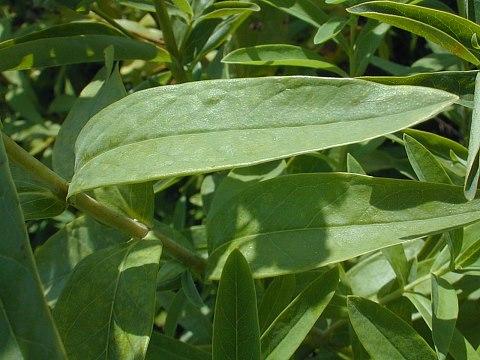
Comments: This species has large attractive flowers and foliage. Unfortunately, the blooming period is relatively short. Giant St. John's Wort is easy to identify because of its large size and the presence of 5 styles on its flowers and seed capsules. Other large Hypericum spp. are usually woody, rather than herbaceous, and they usually have only 1-3 styles. An exception is the woody Hypericum kalmianum (Kalm's St. John's Wort), which also has 5 styles. This latter species has smaller flowers, more narrow leaves, and a shorter and more branched habit of growth than Giant St. John's Wort. Some taxonomists consider North American populations of Giant St. John's Wort to be distinct from the Eurasian populations, and refer to this species as Hypericum pyramidatum. Another common name of this species is Great St. John's Wort.
The central stem and lateral upper stems (if any) terminate in cymes of 1-5 flowers. Relative to the size of the flowers, branches of each cyme are rather short. Each flower is about 2" across, consisting of 5 yellow petals, 5 green sepals, numerous yellow stamens (about 100), and a light green pistil with 5 persistent styles. The petals are widely spreading and often rather floppy or contorted; they may develop streaks of white with age. The sepals are lanceolate-ovate and much shorter than the petals. The blooming period occurs during mid-summer and lasts about 2-3 weeks. Each flower is replaced by a large hairless seed capsule up to 1¼" long and ½" across. Each seed capsule is divided into 5 cells; each cell containsDistribution Map numerous small seeds that are narrowly oblongoid, flattened, and black at maturity. The root system is rhizomatous, often forming small colonies of plants.
Cultivation: The preference is full sun to light shade and moist conditions. This wildflower adapts to different kinds of soil, including loam, clay-loam, and rocky soil. It is robust and easy to grow.
Range & Habitat: The native Giant St. John's Wort is occasional in northern and west-central Illinois; it is rare or absent elsewhere in the state. Illinois lies along the southern range limit of this species in North America; it also occurs in Eurasia. Habitats are rather variable, but they include woodland openings, wooded slopes, banks of rivers and streams, moist thickets and meadows, river-bottom prairies, and fens. This species is usually found in high quality habitats. It is sometimes cultivated in gardens.
Faunal Associations: The flowers are pollinated primarily by bumblebees, which collect pollen. Smaller bees and other insects may visit the flowers as well, but they are less effective pollinators. Only pollen is available as a reward to floral visitors. Some insects feed on the leaves, flowers, and other parts of this and other Hypericum spp. (St. John's Wort species). These include the caterpillars of the moths Eupithecia miserulata (Common Pug), Melanchra assimilis (Black Arches), Synchlora aerata (Wavy-Lined Emerald), Hyppa xylinodes (Common Hyppa), Nedra ramosula (Gray Half-Spot), and Agonopterix hyperella (Oecophorid Moth sp.). The caterpillars of the butterfly Strymon melinus (Gray Hairstreak) feed on the developing capsules and seeds. Other insects that feed on Hypericum spp. include the aphid Brachysiphum hyperici, and the leaf beetles Pachybrachis relictus and Paria sellata. The foliage is somewhat toxic to mammalian herbivores and usually avoided because it can cause irritation of the gastrointestinal tract. The foliage can also cause a harmful reaction to sunlight in light-skinned animals (e.g., pigs), causing irritation of the skin.
Photographic Location: A restored prairie at Meadowbrook Park in Urbana, Illinois.

Comments: This species has large attractive flowers and foliage. Unfortunately, the blooming period is relatively short. Giant St. John's Wort is easy to identify because of its large size and the presence of 5 styles on its flowers and seed capsules. Other large Hypericum spp. are usually woody, rather than herbaceous, and they usually have only 1-3 styles. An exception is the woody Hypericum kalmianum (Kalm's St. John's Wort), which also has 5 styles. This latter species has smaller flowers, more narrow leaves, and a shorter and more branched habit of growth than Giant St. John's Wort. Some taxonomists consider North American populations of Giant St. John's Wort to be distinct from the Eurasian populations, and refer to this species as Hypericum pyramidatum. Another common name of this species is Great St. John's Wort.
0
0
文章
Miss Chen
2018年06月25日

Description: This herbaceous wildflower is a biennial about 1-3' tall. During the first year, it forms a low rosette of leaves, while during the second year it bolts, forming flowering stalks. Small second-year plants branch sparingly, if at all, while robust second-year plants branch readily, especially above. The stems are light green, yellowish green, or reddish green; they are terete and glabrous. Pairs of opposite leaves occur along these stems. Individual leaves are 1-2½" long and ¼-1" across; they are ovate, lanceolate, or narrowly lanceolate in shape and smooth along their margins. Each leaf is rounded at the base, where it is sessile or clasps the stem. Both the lower and upper surfaces of the leaves are yellowish green to medium green and glabrous. The leaves have prominent central veins and a slightly succulent texture.

Upper stems terminate with individual flowers on long peduncles (up to 8" in length). Each flower is 1½-2½" long, consisting of a broad tubular corolla with spreading 4 lobes that are rounded and fringed, 4 lanceolate to ovate sepals that are about one-half the length of the corolla, 4 inserted stamens, and a pistil with a short style. The corolla varies in color from medium blue to deep dark blue. The sepals are light green to reddish green, glabrous, and keeled; 2 sepals are shorter than the other 2 sepals. The shorter sepals have membranous margins. The upright peduncles are light green to reddish green and glabrous; they are terete and sometimes slightly ribbed (striated). The blooming period occurs from early to mid-fall and lasts about 1½-2 months. The flowers are diurnal, opening up on sunny days, while remaining closed on cloudy days and during the night. There is no noticeable floral scent. The flowersStems & Opposite Leaves are replaced by elongated seed capsules. Individual capsules divide into 2 parts to release the numerous tiny seeds within. To some extent, they are distributed by wind and water. The seed surface is minutely bumpy. The root system consists of a shallow branching taproot. This wildflower reproduces by reseeding itself.
Cultivation: The preference is full or partial sun, somewhat wet to moist conditions, and calcareous sandy soil with a neutral pH. Insect pests and disease organisms rarely bother this wildflower. Robust plants can sprawl if they are not supported by adjacent vegetation.
Range & Habitat: Fringed Gentian is a rare native wildflower that is found in NE Illinois, while in the rest of the state it is absent (see Distribution Map). While populations have declined from habitat destruction, Fringed Gentian is not yet listed as 'endangered' or 'threatened' within the state. Habitats include wet to moist sand prairies, sandy pannes near Lake Michigan, edges of sandy sloughs and sandy swales, fens, open wooded swamps, wooded ravines, roadside ditches, and open damp areas along sandy trails. Fringed Gentian is usually associated with high quality wetlands where the original flora is still intact, although it has a tendency to colonize open disturbed areas both in and around these habitats.
Faunal Associations: Information about floral-faunal relationships for this wildflower is scant. The nectar and pollen of the flowers attract primarily bumblebees. Costelloe (1988) observed the following bumblebees visiting the flowers of Fringed Gentian in Ohio: Bombus fervidus, Bombus impatiens, Bombus perplexus, and Bombus vagans. Apparently, the bitter foliage is rarely bothered by insects and mammalian herbivores.
Photographic Location: Edge of a wet sandy meadow along a trail at the Indiana Dunes National Lakeshore in NW Indiana.

Comments: The flowers have an unearthly beauty that is positively stunning; Fringed Gentian ranks among the most attractive of all wildflowers within Illinois. Another similar species in this genus is Gentianopsis procera (Lesser Fringed Gentian). This latter species is a petite version of Fringed Gentian: it is usually shorter with smaller flowers and leaves. The flowers of Lesser Fringed Gentian have corolla lobes that are less deeply fringed, and its leaves are more narrow (becoming linear-lanceolate to nearly linear underneath the flowers). Lesser Fringed Gentian is even less common than Fringed Gentian, preferring similar to slightly wetter habitats. Another common name of Gentianopsis crinita is Greater Fringed Gentian; a scientific synonym of this species is Gentiana crinita.

Upper stems terminate with individual flowers on long peduncles (up to 8" in length). Each flower is 1½-2½" long, consisting of a broad tubular corolla with spreading 4 lobes that are rounded and fringed, 4 lanceolate to ovate sepals that are about one-half the length of the corolla, 4 inserted stamens, and a pistil with a short style. The corolla varies in color from medium blue to deep dark blue. The sepals are light green to reddish green, glabrous, and keeled; 2 sepals are shorter than the other 2 sepals. The shorter sepals have membranous margins. The upright peduncles are light green to reddish green and glabrous; they are terete and sometimes slightly ribbed (striated). The blooming period occurs from early to mid-fall and lasts about 1½-2 months. The flowers are diurnal, opening up on sunny days, while remaining closed on cloudy days and during the night. There is no noticeable floral scent. The flowersStems & Opposite Leaves are replaced by elongated seed capsules. Individual capsules divide into 2 parts to release the numerous tiny seeds within. To some extent, they are distributed by wind and water. The seed surface is minutely bumpy. The root system consists of a shallow branching taproot. This wildflower reproduces by reseeding itself.
Cultivation: The preference is full or partial sun, somewhat wet to moist conditions, and calcareous sandy soil with a neutral pH. Insect pests and disease organisms rarely bother this wildflower. Robust plants can sprawl if they are not supported by adjacent vegetation.
Range & Habitat: Fringed Gentian is a rare native wildflower that is found in NE Illinois, while in the rest of the state it is absent (see Distribution Map). While populations have declined from habitat destruction, Fringed Gentian is not yet listed as 'endangered' or 'threatened' within the state. Habitats include wet to moist sand prairies, sandy pannes near Lake Michigan, edges of sandy sloughs and sandy swales, fens, open wooded swamps, wooded ravines, roadside ditches, and open damp areas along sandy trails. Fringed Gentian is usually associated with high quality wetlands where the original flora is still intact, although it has a tendency to colonize open disturbed areas both in and around these habitats.
Faunal Associations: Information about floral-faunal relationships for this wildflower is scant. The nectar and pollen of the flowers attract primarily bumblebees. Costelloe (1988) observed the following bumblebees visiting the flowers of Fringed Gentian in Ohio: Bombus fervidus, Bombus impatiens, Bombus perplexus, and Bombus vagans. Apparently, the bitter foliage is rarely bothered by insects and mammalian herbivores.
Photographic Location: Edge of a wet sandy meadow along a trail at the Indiana Dunes National Lakeshore in NW Indiana.

Comments: The flowers have an unearthly beauty that is positively stunning; Fringed Gentian ranks among the most attractive of all wildflowers within Illinois. Another similar species in this genus is Gentianopsis procera (Lesser Fringed Gentian). This latter species is a petite version of Fringed Gentian: it is usually shorter with smaller flowers and leaves. The flowers of Lesser Fringed Gentian have corolla lobes that are less deeply fringed, and its leaves are more narrow (becoming linear-lanceolate to nearly linear underneath the flowers). Lesser Fringed Gentian is even less common than Fringed Gentian, preferring similar to slightly wetter habitats. Another common name of Gentianopsis crinita is Greater Fringed Gentian; a scientific synonym of this species is Gentiana crinita.
0
0
文章
Miss Chen
2018年06月21日

Description: This perennial plant is ¾–2½' long. It either floats on water or sprawls across the ground. The stems are light green to red (often the latter), glabrous to sparsely pubescent, and terete. Alternate leaves along these stems are 1¼–3" long and ½–1" across; they are elliptic, oblong-elliptic, oblanceolate, or oblong-oblanceolate in shape and smooth along their margins. The leaves are usually glossy green in appearance, although sometimes they develop patches of red or yellow. The upper leaf surface is glabrous, while the lower leaf surface is glabrous to sparsely pubescent. The leaf bases taper gradually into slender petioles about ½–2" long. Individual flowers develop from the axils of the middle to upper leaves on erect to semi-erect pedicels about 1–3" long. Each flower is about 1" across, consisting of 5 yellow petals, 5 light green sepals, 10 yellow stamens, and a narrowly cylindrical pistil with a single style. The petals are obovate in shape with pale pinnate nerves, while the smaller sepals are lanceolate. Compared to the size of the flower, both the stamens and style are relatively short. Between the apex of the pedicel and the bottom of the pistil, there is a pair of tiny bractlets (about 1.0–1.5 mm. in length). The blooming period occurs from late spring to early fall, lasting several months. The flowers are diurnal.
Afterwards, the flowers are replaced by cylindrical seed capsules about 1–1½" long. Each seed capsule has 5 narrow cells, and each cell contains a row of seeds. The seeds are enclosed in chunky outer coatings (endocarps); they are about 1.0-1.5 mm. in length. The root system is fibrous and fleshy. When the nodes of the stems lie on wet ground, they are capable of developing new fibrous roots, from which new plants are produced vegetatively. Sometimes the root system produces small bladders that keep individual plants more buoyant in the water. This plant often forms large colonies.
Cultivation: The preference is full sun, wet conditions, and muddy soil, although this plant can adapt to shallow water as a floating aquatic. Creeping Water Primrose (Ludwigia peploides glabrescens) can spread aggressively in shallow wetlands and muddy areas. It is potentially invasive.

Range & Habitat: Creeping Water Primrose is locally common and native to southern Illinois, while in the rest of the state it is uncommon and probably adventive in most areas (see Distribution Map). This species is slowly spreading northward. Habitats include borders of ponds, shallow areas of lakes, sluggish streams, swamps, marshes, and ditches. In some of these habitats, Creeping Water Primrose can become the dominant shoreline plant, forming large colonies.
Faunal Associations: The flowers are cross-pollinated primarily by bees, including honeybees, digger bees (Eucerine), and Halictid bees. Other visitors, such as flies and skippers, are less effective at cross-pollination. These insects obtain nectar and/or pollen from the flowers. Some insects feed destructively on Creeping Water Primrose. This includes the flea beetles, Altica litigata and Lysathia ludoviciana, and a leafhopper, Draeculacephala inscripta. The Mallard and possibly other ducks feed on the seed capsules. Because of the large dense colonies that this plant often forms, it provides good cover along shorelines for various insects, frogs, and other wetland wildlife.

Photographic Location: Muddy shore of a pond in southern Illinois.
Comments: Creeping Water Primrose has showy flowers and attractive foliage. Unfortunately, it is sometimes too aggressive for its own good. It can be distinguished from other Ludwigia spp. by its larger 5-petaled flowers and sprawling semi-aquatic habit. Across its range in the United States and tropical America, different varieties of this species have been described, although only var. glabrescens has been found in Illinois. This variety can be distinguished by its more glabrous foliage. Another scientific name of this wetland plant is Jussiaea repens glabrescens, while an alternative common name is Creeping Primrose Willow.
Afterwards, the flowers are replaced by cylindrical seed capsules about 1–1½" long. Each seed capsule has 5 narrow cells, and each cell contains a row of seeds. The seeds are enclosed in chunky outer coatings (endocarps); they are about 1.0-1.5 mm. in length. The root system is fibrous and fleshy. When the nodes of the stems lie on wet ground, they are capable of developing new fibrous roots, from which new plants are produced vegetatively. Sometimes the root system produces small bladders that keep individual plants more buoyant in the water. This plant often forms large colonies.
Cultivation: The preference is full sun, wet conditions, and muddy soil, although this plant can adapt to shallow water as a floating aquatic. Creeping Water Primrose (Ludwigia peploides glabrescens) can spread aggressively in shallow wetlands and muddy areas. It is potentially invasive.

Range & Habitat: Creeping Water Primrose is locally common and native to southern Illinois, while in the rest of the state it is uncommon and probably adventive in most areas (see Distribution Map). This species is slowly spreading northward. Habitats include borders of ponds, shallow areas of lakes, sluggish streams, swamps, marshes, and ditches. In some of these habitats, Creeping Water Primrose can become the dominant shoreline plant, forming large colonies.
Faunal Associations: The flowers are cross-pollinated primarily by bees, including honeybees, digger bees (Eucerine), and Halictid bees. Other visitors, such as flies and skippers, are less effective at cross-pollination. These insects obtain nectar and/or pollen from the flowers. Some insects feed destructively on Creeping Water Primrose. This includes the flea beetles, Altica litigata and Lysathia ludoviciana, and a leafhopper, Draeculacephala inscripta. The Mallard and possibly other ducks feed on the seed capsules. Because of the large dense colonies that this plant often forms, it provides good cover along shorelines for various insects, frogs, and other wetland wildlife.

Photographic Location: Muddy shore of a pond in southern Illinois.
Comments: Creeping Water Primrose has showy flowers and attractive foliage. Unfortunately, it is sometimes too aggressive for its own good. It can be distinguished from other Ludwigia spp. by its larger 5-petaled flowers and sprawling semi-aquatic habit. Across its range in the United States and tropical America, different varieties of this species have been described, although only var. glabrescens has been found in Illinois. This variety can be distinguished by its more glabrous foliage. Another scientific name of this wetland plant is Jussiaea repens glabrescens, while an alternative common name is Creeping Primrose Willow.
0
0
文章
Miss Chen
2018年06月21日

Description: This is a perennial wildflower about 1½-3½' tall that branches occasionally. The stems are light green, red, brown, or nearly white; they are terete and glabrous (except for an uncommon variety with pubescent stems). The alternate leaves are 1¼-4" long and ¼-¾" across; they are narrowly lanceolate or elliptic, smooth along their margins; sometimes their margins are slightly ciliate or they are tinted red. The leaves are light to medium green and glabrous (except for an uncommon variety with pubescent leaves). The leaves are sessile or they have short petioles (less than ½" in length). Leaf venation is pinnate.
Along the upper half of each plant, solitary flowers develop from the axils of the leaves on short pedicels (about 1/8" in length). Each flower is ½-¾" across, consisting of 4 yellow petals, 4 light green sepals, 4 short stamens, and a pistil with a short style. The tip of the style is light green and globular. The petals are oval to obovate in shape, while the sepals are ovate-cordate in shape; both petals and sepals are about the same length. The sepals are glabrous and smooth along their margins; sometimes their margins are slightly ciliate or tinted red. The blooming period occurs during the summer for about 2 months. Each flower remains intact for only a single day; the petals are early-deciduous andDistribution Map become detached when they are exposed to even minor disturbance. Later in the year, the flowers are replaced by seed capsules (about ¼" in length) with a cubic shape that turn brown at maturity. The tiny seeds are released from each capsule by a small pore at its apex. These capsules can float on water or be blown about by the wind, distributing the seeds to new areas. Individual seeds are 0.5-1.0 mm. in length and narrowly ellipsoid in shape. The root system is fleshy and fibrous.
Cultivation: The preference is full to partial sun, wet to moist conditions, and an acidic sandy soil, although other soil types are tolerated.
Range & Habitat: The native Seedbox is occasional in most areas of Illinois, except in parts of central and northern Illinois, where it is either uncommon, rare, or absent. Habitats include openings in floodplain woodlands, sandy swamps, acidic gravelly seeps, low areas along streams and ponds, wet prairies, wet sand prairies, and roadside ditches. The pubescent variety of Seedbox, Ludwigia alternifolia pubescens, occurs in southern Illinois, where it is uncommon.
Faunal Associations: According to Robertson (1929), the flowers of Seedbox are visited primarily by bees, including Halictid bees (Augochlorella spp., Halictus spp., & Lasioglossum spp.) and leaf-cutting bees (Megachile spp.); the bees suck nectar or collect pollen from the flowers. Less common floral visitors include Sphecid wasps, small butterflies, beetles, and other insects. Some insects also feed on the foliage and other parts of Seedbox. These species include the leaf beetle Colaspis suggona, the flea beetle Altica litigata, and caterpillars of the moth Eudryas unio (Pearly Wood Nymph). White-Tailed Deer occasionally browse on the foliage during the summer.
Photographic Location: Edge of a sandy swamp at the Heron Boardwalk in Vermilion County, Illinois.

Comments: Seedbox has showier flowers than most Ludwigia spp., and its cubic seed capsules have a distinct appearance. As a result, it is fairly easily to identify when either the flowers or seed capsules are present. Species in this genus are usually found in wetlands. Species in a related genus of the Evening Primrose family, Epilobium spp. (Willow-Herbs), have similar foliage and prefer similar habitats. They can be distinguished from Ludwigia spp. by their narrowly cylindrical seedpods and the presence of tufts of hair on their seeds.
Along the upper half of each plant, solitary flowers develop from the axils of the leaves on short pedicels (about 1/8" in length). Each flower is ½-¾" across, consisting of 4 yellow petals, 4 light green sepals, 4 short stamens, and a pistil with a short style. The tip of the style is light green and globular. The petals are oval to obovate in shape, while the sepals are ovate-cordate in shape; both petals and sepals are about the same length. The sepals are glabrous and smooth along their margins; sometimes their margins are slightly ciliate or tinted red. The blooming period occurs during the summer for about 2 months. Each flower remains intact for only a single day; the petals are early-deciduous andDistribution Map become detached when they are exposed to even minor disturbance. Later in the year, the flowers are replaced by seed capsules (about ¼" in length) with a cubic shape that turn brown at maturity. The tiny seeds are released from each capsule by a small pore at its apex. These capsules can float on water or be blown about by the wind, distributing the seeds to new areas. Individual seeds are 0.5-1.0 mm. in length and narrowly ellipsoid in shape. The root system is fleshy and fibrous.
Cultivation: The preference is full to partial sun, wet to moist conditions, and an acidic sandy soil, although other soil types are tolerated.
Range & Habitat: The native Seedbox is occasional in most areas of Illinois, except in parts of central and northern Illinois, where it is either uncommon, rare, or absent. Habitats include openings in floodplain woodlands, sandy swamps, acidic gravelly seeps, low areas along streams and ponds, wet prairies, wet sand prairies, and roadside ditches. The pubescent variety of Seedbox, Ludwigia alternifolia pubescens, occurs in southern Illinois, where it is uncommon.
Faunal Associations: According to Robertson (1929), the flowers of Seedbox are visited primarily by bees, including Halictid bees (Augochlorella spp., Halictus spp., & Lasioglossum spp.) and leaf-cutting bees (Megachile spp.); the bees suck nectar or collect pollen from the flowers. Less common floral visitors include Sphecid wasps, small butterflies, beetles, and other insects. Some insects also feed on the foliage and other parts of Seedbox. These species include the leaf beetle Colaspis suggona, the flea beetle Altica litigata, and caterpillars of the moth Eudryas unio (Pearly Wood Nymph). White-Tailed Deer occasionally browse on the foliage during the summer.
Photographic Location: Edge of a sandy swamp at the Heron Boardwalk in Vermilion County, Illinois.

Comments: Seedbox has showier flowers than most Ludwigia spp., and its cubic seed capsules have a distinct appearance. As a result, it is fairly easily to identify when either the flowers or seed capsules are present. Species in this genus are usually found in wetlands. Species in a related genus of the Evening Primrose family, Epilobium spp. (Willow-Herbs), have similar foliage and prefer similar habitats. They can be distinguished from Ludwigia spp. by their narrowly cylindrical seedpods and the presence of tufts of hair on their seeds.
0
0
文章
Miss Chen
2018年06月21日

Description: This herbaceous perennial plant is usually unbranched and 2–3½' tall. The central stem is light green, terete, and sparingly to densely hairy. The alternate leaves are up 6" long and 1½" across, but they are typically about one-half of this maximum size. The rough-textured leaves are lanceolate in shape and coarsely serrated along their margins; they have a tendency to curl upward along their central veins. The lower leaves have short petioles, while the upper ones are sessile. The undersides of leaves usually have fine hairs.
The central stem terminates in a spike-like raceme of showy red flowers (rarely white). This raceme is about ½–1½' long. The red corolla of each flower has a narrow tubular structure that is upright and terminates in grayish white reproductive organs; these organs nod downward. Beneath this are 2 narrow lateral lobes and a lower lip that is 3-lobed. The green calyx is deeply divided into 5 linear teeth that spread outward. The flowers are held at an upward angle in relation to the stem; they are about 1–1½" long and ¾–1" across. The blooming period occurs from late summer to early fall, lasting about 1–1½ months. There is no floral scent. The small seeds can be carried aloft by the wind. The root system consists of a taproot.

Cultivation: The preference is light shade to full sun, and wet to moist conditions. Cardinal Flower adapts to loam, sandy loam, or gravelly soil; the soil should contain some organic matter to retain moisture. This plant doesn't like to dry out and it has a reputation of being temperamental and short-lived. It is easier to establish this plant using transplants, as the seeds are quite small and the young seedlings are rather fragile.

Range & Habitat: The native Cardinal Flower has been observed in most counties of Illinois; it is occasional to locally common in southern Illinois, while in northern and central Illinois it tends to be less common or absent (see Distribution Map). Habitats include wet prairies, prairie swales, openings in floodplain and bottomland woodlands, soggy meadows along rivers and streams, gravelly seeps and springs, borders of ponds, edges of small marshes, and ditches. These habitats include both sandy and non-sandy areas. Cardinal Flower is often found in sunny areas near sources of water, or it is found in open woodland areas where moist depressions occur.

Faunal Associations: The nectar of the flowers attracts the Ruby-Throated Hummingbird and various Swallowtail butterflies, including such species as Papilio polyxenes asterias (Black Swallowtail), Papilio troilus (Spicebush Swallowtail), and Battus philenor (Pipevine Swallowtail). Sometimes the larger bumblebees will steal nectar through slits in the tubular corolla. Halictid bees sometimes gather pollen, but they are ineffective at pollination. The larvae of a polyphagous fly, Metopomyza scutellata, mine the leaves of Cardinal Flower. The caterpillars of a moth, Enigmogramma basigera (Pink-washed Looper Moth), also feed on the leaves (Schweitzer & Roberts, 2007). The seeds are too small to be of much interest to birds. Mammalian herbivores usually don't consume this plant because of the toxic white latex in the foliage. While it's a beautiful plant, the ecological value of Cardinal Flower to wildlife is relatively low.
Photographic Location: Most of the photographs were taken by the webmaster at Meadowbrook Park in Urbana, Illinois; the plants were growing in a prairie swale. The photograph of a Cardinal Plant with rare white flowers was taken by Paul Showers (Copyright © 2013) in northeast Illinois.

Comments: The Cardinal Flower has striking red flowers that remind me of the Northern Cardinal and other exotic birds. Red is an unusual color in wildflowers – an attribute that it shares with Silene regia (Royal Catchfly) and Silene virginica (Fire Pink). Plants with red flowers typically attract hummingbirds; sometimes they also attract Swallowtail butterflies because their compound eyes, unlike those of bees, can detect the color red. The Cardinal Flower is often sold at garden centers, but such plants are often hybrids or special cultivars. One such hybrid is Lobelia X speciosa, which is a genetic cross of Lobelia cardinalis and Lobelia siphilitica (Great Blue Lobelia). This hybrid can naturalize in the wild, and resembles the former species to a greater extent than the latter. Its flowers are often magenta or deep rose, rather than brilliant red.
The central stem terminates in a spike-like raceme of showy red flowers (rarely white). This raceme is about ½–1½' long. The red corolla of each flower has a narrow tubular structure that is upright and terminates in grayish white reproductive organs; these organs nod downward. Beneath this are 2 narrow lateral lobes and a lower lip that is 3-lobed. The green calyx is deeply divided into 5 linear teeth that spread outward. The flowers are held at an upward angle in relation to the stem; they are about 1–1½" long and ¾–1" across. The blooming period occurs from late summer to early fall, lasting about 1–1½ months. There is no floral scent. The small seeds can be carried aloft by the wind. The root system consists of a taproot.

Cultivation: The preference is light shade to full sun, and wet to moist conditions. Cardinal Flower adapts to loam, sandy loam, or gravelly soil; the soil should contain some organic matter to retain moisture. This plant doesn't like to dry out and it has a reputation of being temperamental and short-lived. It is easier to establish this plant using transplants, as the seeds are quite small and the young seedlings are rather fragile.

Range & Habitat: The native Cardinal Flower has been observed in most counties of Illinois; it is occasional to locally common in southern Illinois, while in northern and central Illinois it tends to be less common or absent (see Distribution Map). Habitats include wet prairies, prairie swales, openings in floodplain and bottomland woodlands, soggy meadows along rivers and streams, gravelly seeps and springs, borders of ponds, edges of small marshes, and ditches. These habitats include both sandy and non-sandy areas. Cardinal Flower is often found in sunny areas near sources of water, or it is found in open woodland areas where moist depressions occur.

Faunal Associations: The nectar of the flowers attracts the Ruby-Throated Hummingbird and various Swallowtail butterflies, including such species as Papilio polyxenes asterias (Black Swallowtail), Papilio troilus (Spicebush Swallowtail), and Battus philenor (Pipevine Swallowtail). Sometimes the larger bumblebees will steal nectar through slits in the tubular corolla. Halictid bees sometimes gather pollen, but they are ineffective at pollination. The larvae of a polyphagous fly, Metopomyza scutellata, mine the leaves of Cardinal Flower. The caterpillars of a moth, Enigmogramma basigera (Pink-washed Looper Moth), also feed on the leaves (Schweitzer & Roberts, 2007). The seeds are too small to be of much interest to birds. Mammalian herbivores usually don't consume this plant because of the toxic white latex in the foliage. While it's a beautiful plant, the ecological value of Cardinal Flower to wildlife is relatively low.
Photographic Location: Most of the photographs were taken by the webmaster at Meadowbrook Park in Urbana, Illinois; the plants were growing in a prairie swale. The photograph of a Cardinal Plant with rare white flowers was taken by Paul Showers (Copyright © 2013) in northeast Illinois.

Comments: The Cardinal Flower has striking red flowers that remind me of the Northern Cardinal and other exotic birds. Red is an unusual color in wildflowers – an attribute that it shares with Silene regia (Royal Catchfly) and Silene virginica (Fire Pink). Plants with red flowers typically attract hummingbirds; sometimes they also attract Swallowtail butterflies because their compound eyes, unlike those of bees, can detect the color red. The Cardinal Flower is often sold at garden centers, but such plants are often hybrids or special cultivars. One such hybrid is Lobelia X speciosa, which is a genetic cross of Lobelia cardinalis and Lobelia siphilitica (Great Blue Lobelia). This hybrid can naturalize in the wild, and resembles the former species to a greater extent than the latter. Its flowers are often magenta or deep rose, rather than brilliant red.
2
0








